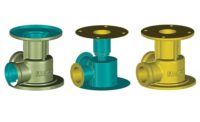Reverse Engineering Software 101
It is the process of converting a physical part into a digital form.

Since the introduction of 3D scanning technology, there has always been a need to process it in some capacity. There has also been a need to provide formats to bridge multiple platforms, getting data to travel through the lifecycle of the process. From conception, to digital form via 3D scanning, to a useable file for additive or subtractive manufacturing. For a while these steps have required a multitude of software to capture, manipulate, tesselate meshes, simplify surfaces and generate worthy CAD data for manufacturing. Back in the late ‘90s a scanning process may have taken a day or longer in its native software to capture 3D geometry. That data was then exported to a mesh processing software, where data is tessellated, edited (cleaning noisy data), a NURBS (Non-Uniform Rational B-Splines) model may be created, exported to a native CAD package like Solidworks, or Pro-E. Since most CAD packages at the time did not like large mesh sets, this was the smoothest path.
Once imported into a CAD program, cross sections could be generated off the NURBS import, and true, native parametric features could be created. With one caveat…once a parametric file was created it needed to be validated. As analytic software was coming into its own at this time, loading the original scan data set, and comparing your best-guess CAD file was another cumbersome step. As you may imagine, this is a “rinse and repeat” step until the model is just right, to yours or your customers’ requirements. From acquisition time to final, digital deliverable could be days or weeks.
In 1998, INUS Technologies, out of South Korea started. Out of that company, a 3D processing software was born, Rapidform. As any new software forms, it was mostly clunky out of the gate, with some core functionality. Fast forward to the early-mid 2000’s, their Rapidform XOR platform is developed and released. This is where the reverse engineering world starts to change as engineers and designer pay notice. A digital shortcut from 3D data acquisition to machine ready data. Collapsing the back and forth, multiplatform crosstalk between software packages. All. In. One.
With a direct interface to multiple CAD software including SolidWorks, Pro/ENGINEER, Siemens NX, CATIA V4/V5 and AutoCAD, the reverse engineering world is changing. I am not speculating that these CAD packages could not do the heavy lifting, but at the time, large meshes and datasets were not their strong suit. Their focus was ground up, from scratch development. Loading in the large data sets would require decimating them, or reducing the polygon count of the mesh. If done incorrectly, this would reduce critical details and sacrifice geometry that may be imperative to the design. This step is now obsolete with Rapidform XOR. Its robust capabilities to handle large data sets, and create CAD features dramatically streamlined this process.
Fast forward to 2012-2013, additive manufacturing juggernaut, 3D Systems, acquires both Geomagic (another 3D data processing company) and Rapidform. Personally, being an avid user of Geomagic (formerly Raindrop Geomagic) for over 21 years, there was an audible gulp when I heard of the acquisition. Since my career was mostly centered around Geomagic’s capabilities I was nervous of the merger. As of date, it was a good move. 3D Systems is now taking these two powerful platforms and combining bits and pieces to optimize the user inputs and dramatically change the way we process data.
So let’s get into a brief explanation of reverse engineering. As I define it, it is the process of converting a physical part into a digital form. There are many facets to this, as the deliverables are vast. Reverse engineering can stop at many parts in the process, per my definition. Simply 3D scanning a part with a laser or structured light system yields a digital point cloud. A large mass of X, Y & Z points in space, each defined by a coordinate value. At this stage we have satisfied my original definition. In this current day and age, a point cloud is rarely good enough to satisfy any downstream process. With one exception coming to mind with LIDAR, or extremely long range data sets, think scanning a football stadium for scale. The point cloud may be adequate to document where things were at that time and place of scanning.
Next is satisfying the additive world. Most requirements are a tessellated mesh. This converts all those aforementioned points into a simplified skin, made up of thousands-to-millions of polygons. This mesh, commonly referred to as STL (stereolithography) format. Since most corporate entities aren’t to privy to pony up their CAD data for their product, this reverse engineering path gets a tangible copy of the part that was 3D scanned. Next variable is converting that 3D scan data into engineering functionality, or parametric design. Parametric can be simply defined, by introducing constraints and relationships to the created 3D features. This allows a designer or engineer to add intent.
Looking for a reprint of this article?
From high-res PDFs to custom plaques, order your copy today!





